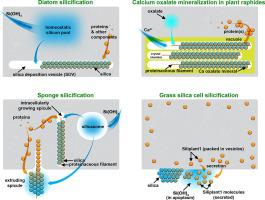Journal of Structural Biology ( IF 3.0 ) Pub Date : 2020-11-20 , DOI: 10.1016/j.jsb.2020.107665 Santosh Kumar 1 , Filipe Natalio 2 , Rivka Elbaum 3

|
Biomineralization is a common strategy adopted by organisms to support their body structure. Plants practice significant silicon and calcium based biomineralization in which silicon is deposited as silica in cell walls and intracellularly in various cell-types, while calcium is deposited mostly as calcium oxalate in vacuoles of specialized cells. In this review, we compare cellular processes leading to protein-dependent mineralization in plants, diatoms and sponges (phylum Porifera). The mechanisms of biomineralization in these organisms are inherently different. The composite silica structure in diatoms forms inside the cytoplasm in a membrane bound vesicle, which after maturation is exocytosed to the cell surface. In sponges, separate vesicles with the mineral precursor (silicic acid), an inorganic template, and organic molecules, fuse together and are extruded to the extracellular space. In plants, calcium oxalate mineral precipitates in vacuolar crystal chambers containing a protein matrix which is never exocytosed. Silica deposition in grass silica cells takes place outside the cell membrane when the cells secrete the mineralizing protein into the apoplasm rich with silicic acid (the mineral precursor molecules). Our review infers that the organism complexity and precursor reactivity (calcium and oxalate versus silicic acid) are main driving forces for the evolution of varied mineralization mechanisms.
中文翻译:

蛋白质驱动的生物矿化:将草二氧化硅细胞中的二氧化硅形成与其他生物矿化过程进行比较
生物矿化是生物体为支持其身体结构而采用的一种常见策略。植物进行重要的基于硅和钙的生物矿化,其中硅以二氧化硅的形式沉积在细胞壁和细胞内的各种细胞类型中,而钙主要以草酸钙的形式沉积在特化细胞的液泡中。在这篇综述中,我们比较了导致植物、硅藻和海绵(Porifera 门)中蛋白质依赖性矿化的细胞过程。这些生物体的生物矿化机制本质上是不同的。硅藻中的复合二氧化硅结构在细胞质内形成膜结合囊泡,成熟后胞吐到细胞表面。在海绵中,用矿物前体(硅酸)、无机模板和有机分子分离囊泡,融合在一起并被挤压到细胞外空间。在植物中,草酸钙矿物沉淀在液泡晶体室中,其中含有从不胞吐的蛋白质基质。当细胞将矿化蛋白分泌到富含硅酸(矿物前体分子)的质外质中时,草二氧化硅细胞中的二氧化硅沉积发生在细胞膜外。我们的评论推断,生物体的复杂性和前体反应性(钙和草酸盐与硅酸)是各种矿化机制演变的主要驱动力。当细胞将矿化蛋白分泌到富含硅酸(矿物前体分子)的质外质中时,草二氧化硅细胞中的二氧化硅沉积发生在细胞膜外。我们的评论推断,生物体的复杂性和前体反应性(钙和草酸盐与硅酸)是各种矿化机制演变的主要驱动力。当细胞将矿化蛋白分泌到富含硅酸(矿物前体分子)的质外质中时,草二氧化硅细胞中的二氧化硅沉积发生在细胞膜外。我们的评论推断,生物体的复杂性和前体反应性(钙和草酸盐与硅酸)是各种矿化机制演变的主要驱动力。











































 京公网安备 11010802027423号
京公网安备 11010802027423号